Healthcare Industries - Palliative Care
VerifiedAdded on 2022/09/11
|7
|1653
|16
AI Summary
Contribute Materials
Your contribution can guide someone’s learning journey. Share your
documents today.

Running head: PALLIATIVE CARE
Palliative care
Name
ID
Course
Unit
Lecturer
Date
Palliative care
Name
ID
Course
Unit
Lecturer
Date
Secure Best Marks with AI Grader
Need help grading? Try our AI Grader for instant feedback on your assignments.
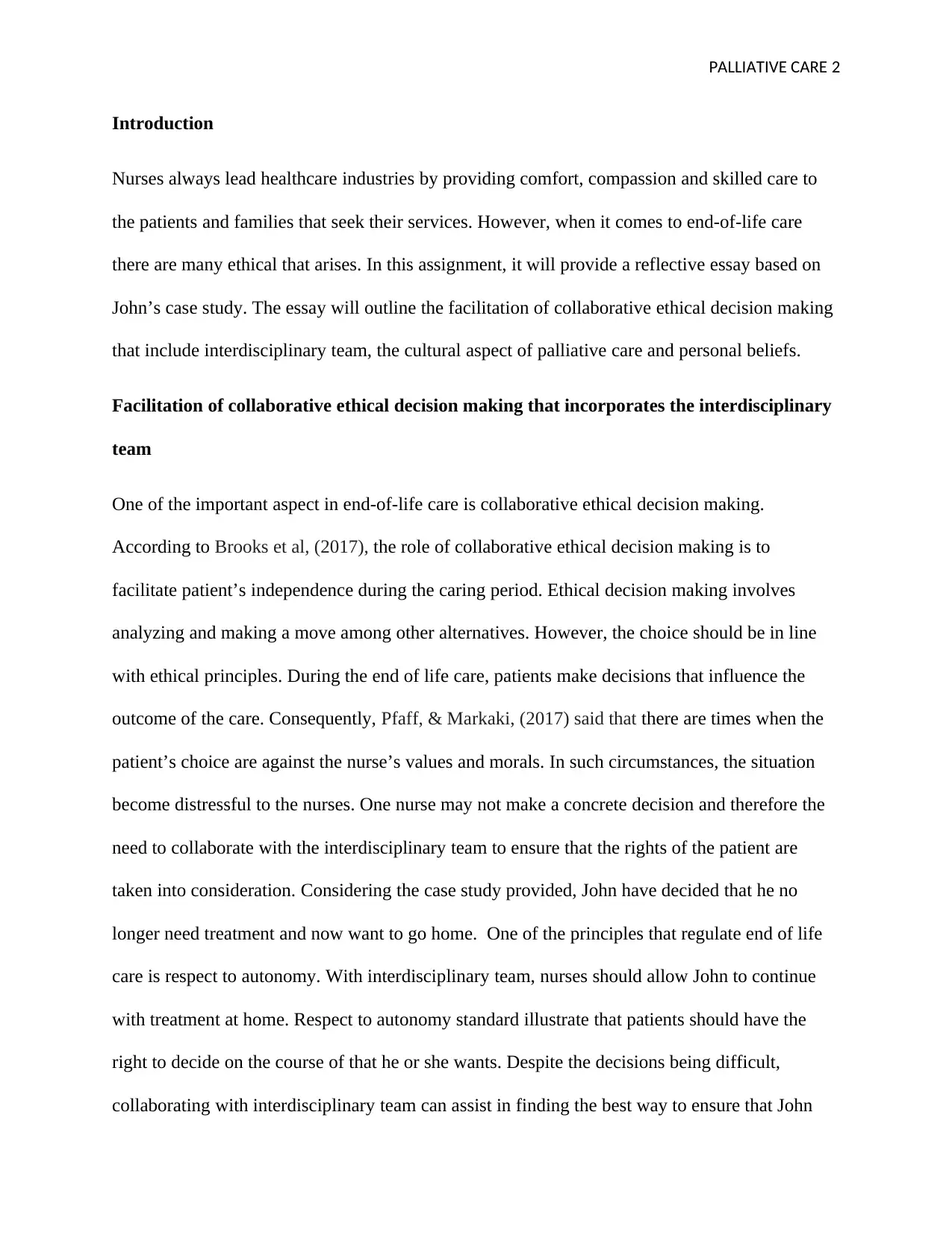
PALLIATIVE CARE 2
Introduction
Nurses always lead healthcare industries by providing comfort, compassion and skilled care to
the patients and families that seek their services. However, when it comes to end-of-life care
there are many ethical that arises. In this assignment, it will provide a reflective essay based on
John’s case study. The essay will outline the facilitation of collaborative ethical decision making
that include interdisciplinary team, the cultural aspect of palliative care and personal beliefs.
Facilitation of collaborative ethical decision making that incorporates the interdisciplinary
team
One of the important aspect in end-of-life care is collaborative ethical decision making.
According to Brooks et al, (2017), the role of collaborative ethical decision making is to
facilitate patient’s independence during the caring period. Ethical decision making involves
analyzing and making a move among other alternatives. However, the choice should be in line
with ethical principles. During the end of life care, patients make decisions that influence the
outcome of the care. Consequently, Pfaff, & Markaki, (2017) said that there are times when the
patient’s choice are against the nurse’s values and morals. In such circumstances, the situation
become distressful to the nurses. One nurse may not make a concrete decision and therefore the
need to collaborate with the interdisciplinary team to ensure that the rights of the patient are
taken into consideration. Considering the case study provided, John have decided that he no
longer need treatment and now want to go home. One of the principles that regulate end of life
care is respect to autonomy. With interdisciplinary team, nurses should allow John to continue
with treatment at home. Respect to autonomy standard illustrate that patients should have the
right to decide on the course of that he or she wants. Despite the decisions being difficult,
collaborating with interdisciplinary team can assist in finding the best way to ensure that John
Introduction
Nurses always lead healthcare industries by providing comfort, compassion and skilled care to
the patients and families that seek their services. However, when it comes to end-of-life care
there are many ethical that arises. In this assignment, it will provide a reflective essay based on
John’s case study. The essay will outline the facilitation of collaborative ethical decision making
that include interdisciplinary team, the cultural aspect of palliative care and personal beliefs.
Facilitation of collaborative ethical decision making that incorporates the interdisciplinary
team
One of the important aspect in end-of-life care is collaborative ethical decision making.
According to Brooks et al, (2017), the role of collaborative ethical decision making is to
facilitate patient’s independence during the caring period. Ethical decision making involves
analyzing and making a move among other alternatives. However, the choice should be in line
with ethical principles. During the end of life care, patients make decisions that influence the
outcome of the care. Consequently, Pfaff, & Markaki, (2017) said that there are times when the
patient’s choice are against the nurse’s values and morals. In such circumstances, the situation
become distressful to the nurses. One nurse may not make a concrete decision and therefore the
need to collaborate with the interdisciplinary team to ensure that the rights of the patient are
taken into consideration. Considering the case study provided, John have decided that he no
longer need treatment and now want to go home. One of the principles that regulate end of life
care is respect to autonomy. With interdisciplinary team, nurses should allow John to continue
with treatment at home. Respect to autonomy standard illustrate that patients should have the
right to decide on the course of that he or she wants. Despite the decisions being difficult,
collaborating with interdisciplinary team can assist in finding the best way to ensure that John
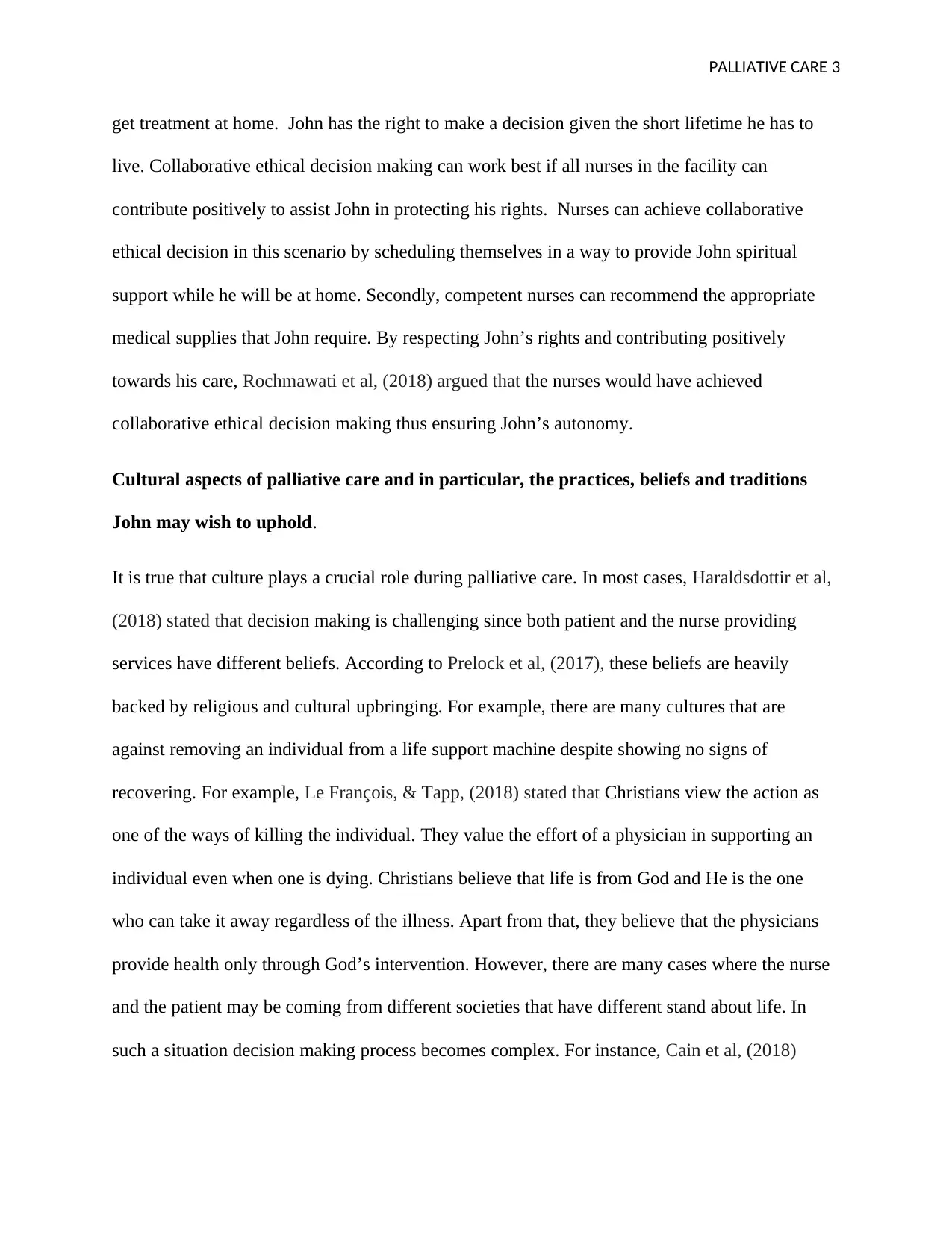
PALLIATIVE CARE 3
get treatment at home. John has the right to make a decision given the short lifetime he has to
live. Collaborative ethical decision making can work best if all nurses in the facility can
contribute positively to assist John in protecting his rights. Nurses can achieve collaborative
ethical decision in this scenario by scheduling themselves in a way to provide John spiritual
support while he will be at home. Secondly, competent nurses can recommend the appropriate
medical supplies that John require. By respecting John’s rights and contributing positively
towards his care, Rochmawati et al, (2018) argued that the nurses would have achieved
collaborative ethical decision making thus ensuring John’s autonomy.
Cultural aspects of palliative care and in particular, the practices, beliefs and traditions
John may wish to uphold.
It is true that culture plays a crucial role during palliative care. In most cases, Haraldsdottir et al,
(2018) stated that decision making is challenging since both patient and the nurse providing
services have different beliefs. According to Prelock et al, (2017), these beliefs are heavily
backed by religious and cultural upbringing. For example, there are many cultures that are
against removing an individual from a life support machine despite showing no signs of
recovering. For example, Le François, & Tapp, (2018) stated that Christians view the action as
one of the ways of killing the individual. They value the effort of a physician in supporting an
individual even when one is dying. Christians believe that life is from God and He is the one
who can take it away regardless of the illness. Apart from that, they believe that the physicians
provide health only through God’s intervention. However, there are many cases where the nurse
and the patient may be coming from different societies that have different stand about life. In
such a situation decision making process becomes complex. For instance, Cain et al, (2018)
get treatment at home. John has the right to make a decision given the short lifetime he has to
live. Collaborative ethical decision making can work best if all nurses in the facility can
contribute positively to assist John in protecting his rights. Nurses can achieve collaborative
ethical decision in this scenario by scheduling themselves in a way to provide John spiritual
support while he will be at home. Secondly, competent nurses can recommend the appropriate
medical supplies that John require. By respecting John’s rights and contributing positively
towards his care, Rochmawati et al, (2018) argued that the nurses would have achieved
collaborative ethical decision making thus ensuring John’s autonomy.
Cultural aspects of palliative care and in particular, the practices, beliefs and traditions
John may wish to uphold.
It is true that culture plays a crucial role during palliative care. In most cases, Haraldsdottir et al,
(2018) stated that decision making is challenging since both patient and the nurse providing
services have different beliefs. According to Prelock et al, (2017), these beliefs are heavily
backed by religious and cultural upbringing. For example, there are many cultures that are
against removing an individual from a life support machine despite showing no signs of
recovering. For example, Le François, & Tapp, (2018) stated that Christians view the action as
one of the ways of killing the individual. They value the effort of a physician in supporting an
individual even when one is dying. Christians believe that life is from God and He is the one
who can take it away regardless of the illness. Apart from that, they believe that the physicians
provide health only through God’s intervention. However, there are many cases where the nurse
and the patient may be coming from different societies that have different stand about life. In
such a situation decision making process becomes complex. For instance, Cain et al, (2018)
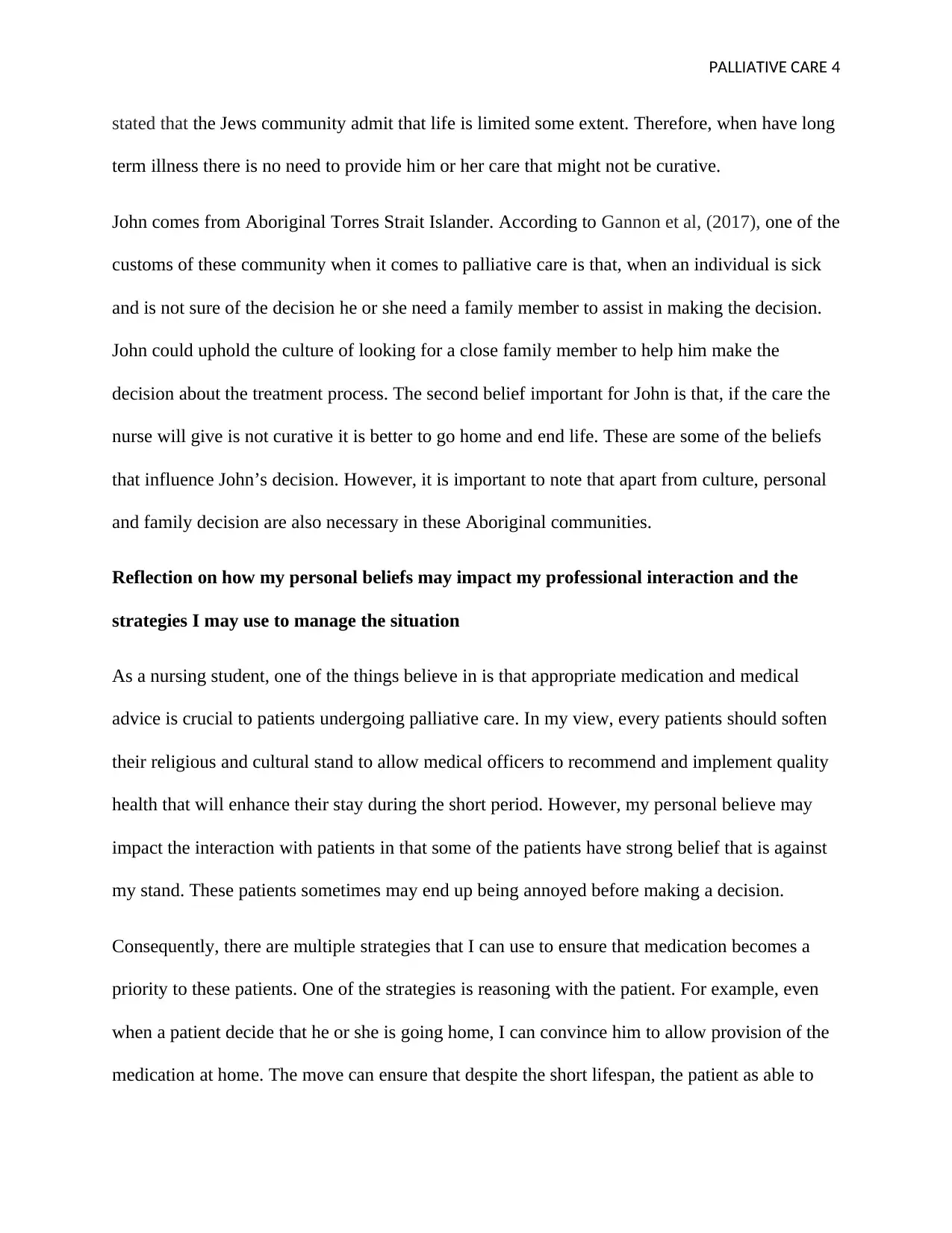
PALLIATIVE CARE 4
stated that the Jews community admit that life is limited some extent. Therefore, when have long
term illness there is no need to provide him or her care that might not be curative.
John comes from Aboriginal Torres Strait Islander. According to Gannon et al, (2017), one of the
customs of these community when it comes to palliative care is that, when an individual is sick
and is not sure of the decision he or she need a family member to assist in making the decision.
John could uphold the culture of looking for a close family member to help him make the
decision about the treatment process. The second belief important for John is that, if the care the
nurse will give is not curative it is better to go home and end life. These are some of the beliefs
that influence John’s decision. However, it is important to note that apart from culture, personal
and family decision are also necessary in these Aboriginal communities.
Reflection on how my personal beliefs may impact my professional interaction and the
strategies I may use to manage the situation
As a nursing student, one of the things believe in is that appropriate medication and medical
advice is crucial to patients undergoing palliative care. In my view, every patients should soften
their religious and cultural stand to allow medical officers to recommend and implement quality
health that will enhance their stay during the short period. However, my personal believe may
impact the interaction with patients in that some of the patients have strong belief that is against
my stand. These patients sometimes may end up being annoyed before making a decision.
Consequently, there are multiple strategies that I can use to ensure that medication becomes a
priority to these patients. One of the strategies is reasoning with the patient. For example, even
when a patient decide that he or she is going home, I can convince him to allow provision of the
medication at home. The move can ensure that despite the short lifespan, the patient as able to
stated that the Jews community admit that life is limited some extent. Therefore, when have long
term illness there is no need to provide him or her care that might not be curative.
John comes from Aboriginal Torres Strait Islander. According to Gannon et al, (2017), one of the
customs of these community when it comes to palliative care is that, when an individual is sick
and is not sure of the decision he or she need a family member to assist in making the decision.
John could uphold the culture of looking for a close family member to help him make the
decision about the treatment process. The second belief important for John is that, if the care the
nurse will give is not curative it is better to go home and end life. These are some of the beliefs
that influence John’s decision. However, it is important to note that apart from culture, personal
and family decision are also necessary in these Aboriginal communities.
Reflection on how my personal beliefs may impact my professional interaction and the
strategies I may use to manage the situation
As a nursing student, one of the things believe in is that appropriate medication and medical
advice is crucial to patients undergoing palliative care. In my view, every patients should soften
their religious and cultural stand to allow medical officers to recommend and implement quality
health that will enhance their stay during the short period. However, my personal believe may
impact the interaction with patients in that some of the patients have strong belief that is against
my stand. These patients sometimes may end up being annoyed before making a decision.
Consequently, there are multiple strategies that I can use to ensure that medication becomes a
priority to these patients. One of the strategies is reasoning with the patient. For example, even
when a patient decide that he or she is going home, I can convince him to allow provision of the
medication at home. The move can ensure that despite the short lifespan, the patient as able to
Secure Best Marks with AI Grader
Need help grading? Try our AI Grader for instant feedback on your assignments.
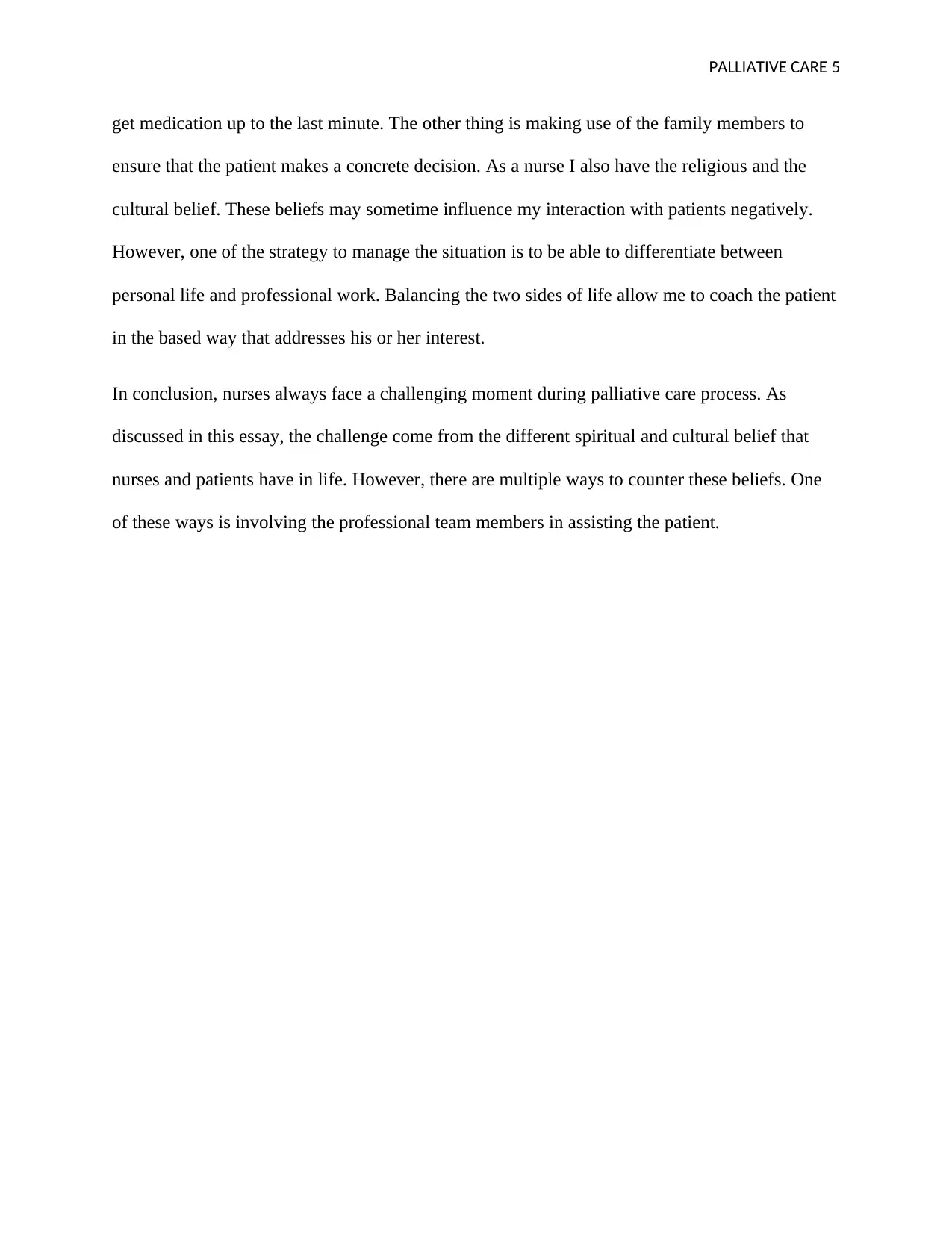
PALLIATIVE CARE 5
get medication up to the last minute. The other thing is making use of the family members to
ensure that the patient makes a concrete decision. As a nurse I also have the religious and the
cultural belief. These beliefs may sometime influence my interaction with patients negatively.
However, one of the strategy to manage the situation is to be able to differentiate between
personal life and professional work. Balancing the two sides of life allow me to coach the patient
in the based way that addresses his or her interest.
In conclusion, nurses always face a challenging moment during palliative care process. As
discussed in this essay, the challenge come from the different spiritual and cultural belief that
nurses and patients have in life. However, there are multiple ways to counter these beliefs. One
of these ways is involving the professional team members in assisting the patient.
get medication up to the last minute. The other thing is making use of the family members to
ensure that the patient makes a concrete decision. As a nurse I also have the religious and the
cultural belief. These beliefs may sometime influence my interaction with patients negatively.
However, one of the strategy to manage the situation is to be able to differentiate between
personal life and professional work. Balancing the two sides of life allow me to coach the patient
in the based way that addresses his or her interest.
In conclusion, nurses always face a challenging moment during palliative care process. As
discussed in this essay, the challenge come from the different spiritual and cultural belief that
nurses and patients have in life. However, there are multiple ways to counter these beliefs. One
of these ways is involving the professional team members in assisting the patient.
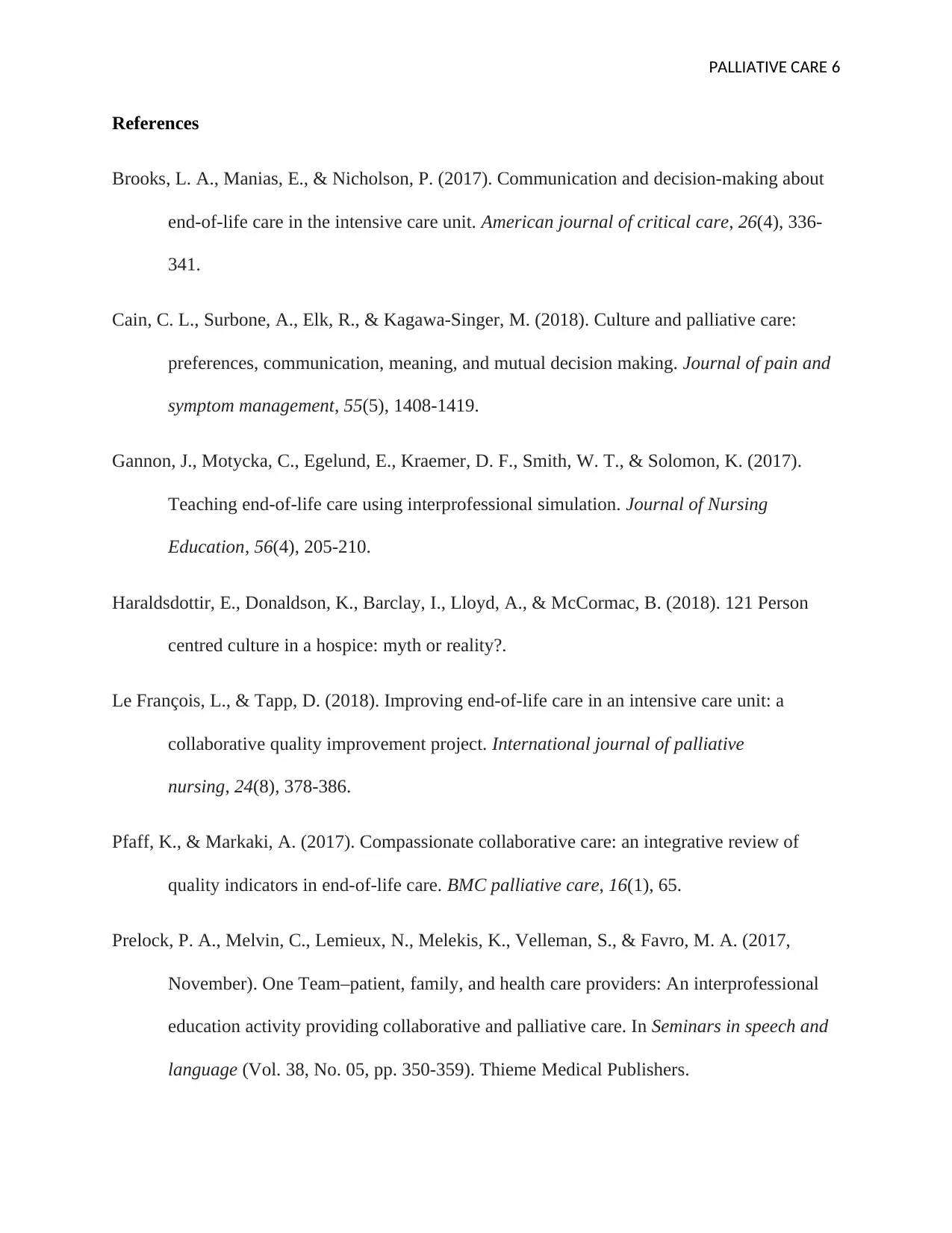
PALLIATIVE CARE 6
References
Brooks, L. A., Manias, E., & Nicholson, P. (2017). Communication and decision-making about
end-of-life care in the intensive care unit. American journal of critical care, 26(4), 336-
341.
Cain, C. L., Surbone, A., Elk, R., & Kagawa-Singer, M. (2018). Culture and palliative care:
preferences, communication, meaning, and mutual decision making. Journal of pain and
symptom management, 55(5), 1408-1419.
Gannon, J., Motycka, C., Egelund, E., Kraemer, D. F., Smith, W. T., & Solomon, K. (2017).
Teaching end-of-life care using interprofessional simulation. Journal of Nursing
Education, 56(4), 205-210.
Haraldsdottir, E., Donaldson, K., Barclay, I., Lloyd, A., & McCormac, B. (2018). 121 Person
centred culture in a hospice: myth or reality?.
Le François, L., & Tapp, D. (2018). Improving end-of-life care in an intensive care unit: a
collaborative quality improvement project. International journal of palliative
nursing, 24(8), 378-386.
Pfaff, K., & Markaki, A. (2017). Compassionate collaborative care: an integrative review of
quality indicators in end-of-life care. BMC palliative care, 16(1), 65.
Prelock, P. A., Melvin, C., Lemieux, N., Melekis, K., Velleman, S., & Favro, M. A. (2017,
November). One Team–patient, family, and health care providers: An interprofessional
education activity providing collaborative and palliative care. In Seminars in speech and
language (Vol. 38, No. 05, pp. 350-359). Thieme Medical Publishers.
References
Brooks, L. A., Manias, E., & Nicholson, P. (2017). Communication and decision-making about
end-of-life care in the intensive care unit. American journal of critical care, 26(4), 336-
341.
Cain, C. L., Surbone, A., Elk, R., & Kagawa-Singer, M. (2018). Culture and palliative care:
preferences, communication, meaning, and mutual decision making. Journal of pain and
symptom management, 55(5), 1408-1419.
Gannon, J., Motycka, C., Egelund, E., Kraemer, D. F., Smith, W. T., & Solomon, K. (2017).
Teaching end-of-life care using interprofessional simulation. Journal of Nursing
Education, 56(4), 205-210.
Haraldsdottir, E., Donaldson, K., Barclay, I., Lloyd, A., & McCormac, B. (2018). 121 Person
centred culture in a hospice: myth or reality?.
Le François, L., & Tapp, D. (2018). Improving end-of-life care in an intensive care unit: a
collaborative quality improvement project. International journal of palliative
nursing, 24(8), 378-386.
Pfaff, K., & Markaki, A. (2017). Compassionate collaborative care: an integrative review of
quality indicators in end-of-life care. BMC palliative care, 16(1), 65.
Prelock, P. A., Melvin, C., Lemieux, N., Melekis, K., Velleman, S., & Favro, M. A. (2017,
November). One Team–patient, family, and health care providers: An interprofessional
education activity providing collaborative and palliative care. In Seminars in speech and
language (Vol. 38, No. 05, pp. 350-359). Thieme Medical Publishers.

PALLIATIVE CARE 7
Rochmawati, E., Wiechula, R., & Cameron, K. (2018). Centrality of spirituality/religion in the
culture of palliative care service in Indonesia: An ethnographic study. Nursing & health
sciences, 20(2), 231-237.
Rochmawati, E., Wiechula, R., & Cameron, K. (2018). Centrality of spirituality/religion in the
culture of palliative care service in Indonesia: An ethnographic study. Nursing & health
sciences, 20(2), 231-237.
1 out of 7
Related Documents
Your All-in-One AI-Powered Toolkit for Academic Success.
+13062052269
info@desklib.com
Available 24*7 on WhatsApp / Email
![[object Object]](/_next/static/media/star-bottom.7253800d.svg)
Unlock your academic potential
© 2024 | Zucol Services PVT LTD | All rights reserved.





